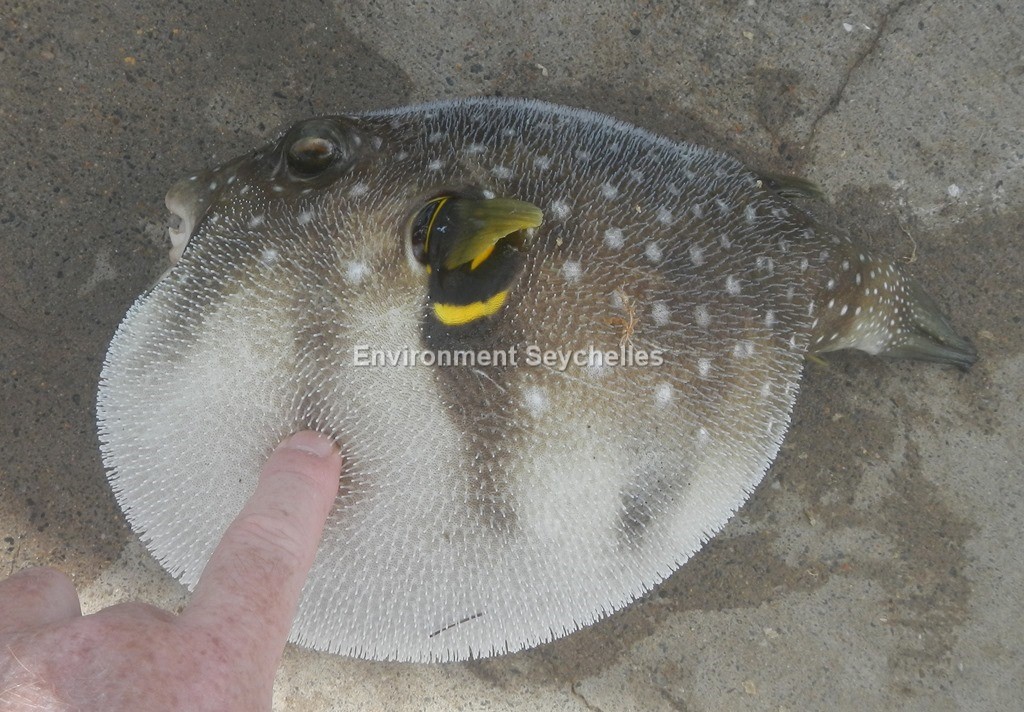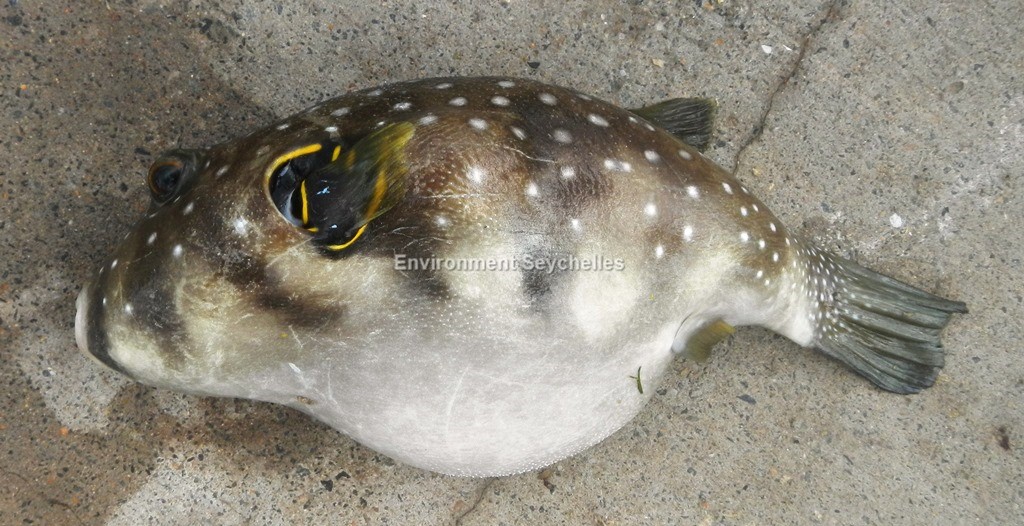Description:
Dorsal spines: 0; Dorsal rays: 10-11; Anal spines: 0; Anal rays: 10-11.
Typical rounded body shape of pufferfish. Single dorsal fin positioned posteriorly on the body, above the similarly-sized anal fin. Each nostril with two fleshy solid
tentacles. Restricted gill opening. The mouth is beak-like. The teeth in both the upper and lower jaws are fused into two "plates".
Body is greenish brown dorsally and white ventrally. Flanks with 5-6 darker greenish brown bars descending ventrally breaking up the lower pale flanks. Exhibits
distinctive white spots on dorsal surface down to mid flank and becoming smaller and more numerous on the caudal peduncle. Alternating pale and dark rings around
the pectoral-fin base and gill opening, and usually a white ring around the eye. Body with small spines except around snout and caudal peduncle. Can inflate itself
(with air or water) when disturbed to several times its normal size causing spines to project and stand erect.
Size:
Maturity: unknown. Max Length: 50.0cm TL
Habitat and Ecology:
Inhabits inner reef flats, lagoons and outer reef slopes (depth 1-50m). Usually solitary and territorial on sandy to rubble areas. Juveniles found in weedy coastal areas
and mangroves.
Feeds on fleshy, calcareous, or coralline algae, detritus, and a range of benthic invertebrates. Also known to prey upon Crown-of-Thorns Starfish, Acanthaster planci,
and may provide ecosystem services by regulating the population of this destructive starfish.
Fishery Status:
This species is not protected or dubject to fishery regulations.It is caught in the fish trap fishery, but is an uncommon component of the catch and is discarded due
to being poisonous to eat.
Notes:
Poisonous to eat. Capable of producing and accumulating toxins in the skin, gonads, and liver.
References:
Bray, D.J. Arothron hispidus in Fishes of Australia, http://136.154.202.208/home/species/845 (08/02/20)
Froese, R. & D. Pauly. Eds. (2020). FishBase. Arothron hispidus https://www.fishbase.se/summary/5425 (08/02/20).
Hardy, G. et al 2014. Arothron hispidus. The IUCN Red List 2014: e.T193699A2262231. https://dx.doi.org/10.2305/IUCN.UK.2014-3.RLTS.T193699A2262231.en. (08/02/20).
McGrouther, M. (2019). Stars-and-stripes Puffer, Arothron hispidus (Linnaeus, 1758)
https://australianmuseum.net.au/learn/animals/fishes/stars-and-stripes-toadfish-arothron-hispidus-linnaeus-1758/ (08/02/20)
Citation:
Nevill, J.E.G. (2020). Arothron hispidus, White-spotted puffer. Seychelles Seatizens. www.seatizens.sc. https://seatizens.sc/species/arothron-hispidus-linnaeus/ (Edited 24/10/21).




Very well written! The points discussed are highly relevant. For further exploration, I recommend visiting: LEARN MORE. Keen to hear everyone’s opinions!
I like this web site it’s a master piece! Glad
I observed this ohttps://69v.topn google.Blog monetyze